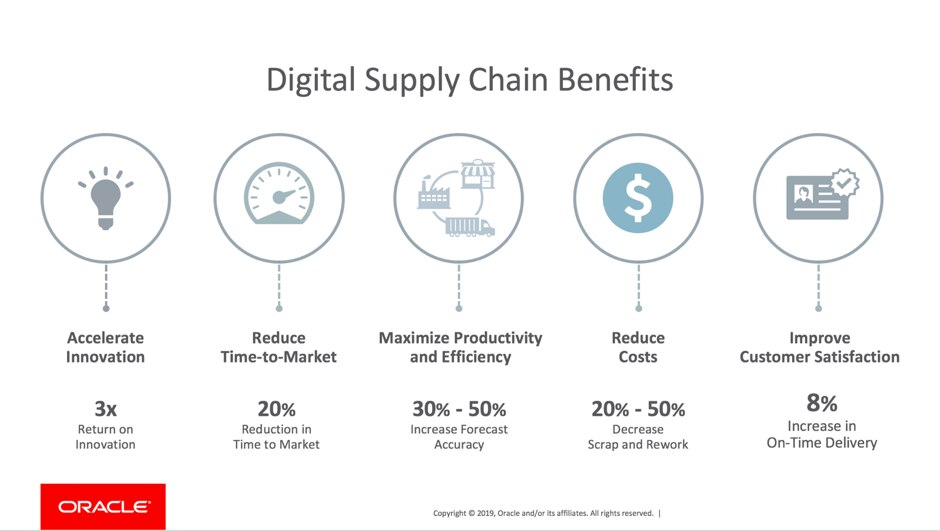Commerce disruptions driven by tariffs, trade wars and a global pandemic have catapulted supply chains into the forefront of business conversation. Suddenly, concepts like supply chain risk, visibility and resilience — once the province of the manufacturing sector — are common topics in business conversations and on front pages of many mainstream media outlets.
Organisations that had invested in making their supply chains sustainable were better prepared for these changes and saw those efforts pay off.
The most impactful spending went toward technologies that underpin the so-called “digital supply chain” and building the processes that enable it.
What Is Digital Supply Chain?
In a typical supply chain, the flow of goods involves designing a product, sourcing and procuring the raw materials and parts, making the product, estimating demand, planning how you’ll market the final product, taking orders, arranging logistics and sales channels and then providing customers with visibility into their orders.
Items tend to travel linearly, with each step dependent on the previous one. While conceptually simple, the linear pre-digital approach to supply chains is dependent on each step in the process performing about as expected. A failure to perform by a subassembly provider or a shipper along the chain may not be discoverable for days or weeks. The result is often missed deadlines and unhappy customers.
A digital supply chain, in contrast, provide significantly more visibility into the workings of the chain. The added near real time visibility of supplier performance and customer needs lets supply chain owners develop more complex relationships with more suppliers — thus indemnifying themselves against most sources of disruptions. Digital supply chains are more customer-centric and aim to meet today’s three pillars of excellence in demand fulfilment: speed, personalisation and choice.
What that means in practice depends on what an organisation is trying to achieve. But in its end game, a digital supply chain integrates internal systems and data with external information, both structured and unstructured. There’s two-way sharing with suppliers and full visibility into the supply chain for all stakeholders. New technologies collect, monitor and analyse data to make predictions and recommend actions in real time.
Digital Supply Chain Explained
A digital supply chain is a set of processes that use advanced technologies and better insights into the functions of each stakeholder along the chain to let each participant make better decisions about the sources of materials they need, the demand for their products and all of the relationship in between.
Fully integrating legacy supply chain management technologies — demand planning, asset management, warehouse management, transportation and logistics management, procurement, order fulfilment — is a needed first step. But truly digitising a supply chain also involves mining data from those processes and instrumenting the equipment that enables them to produce the needed data.
The instrumentation of the supply chain is done with sensors and monitors that collectively have become known as the Internet of Things (IoT). The technology is typically used to monitor manufacturing or logistics processes. Through the use of gateways, that data can be shared with stakeholders along the supply chain. The data is then aggregated and used by stakeholders to assess whether they can reliably expect the products they need.
A clothing retailer could know not only how many green, medium shirts of a style are in a warehouse, they might also know how many are being manufactured at a given time, and where their order sits in the manufacturing queue. Collecting this data across a number of suppliers can help the retailer ensure that they have just the right inventory across its stores without having to carry excess stock.
The systems that collect and analyse the data do so in near real time, providing far more timely visibility into the workings of the supply chain than could otherwise be had.
But making sense of all that data requires advanced analytics to model it and predict outcomes. Complexity grows as the number suppliers, parts, distributors and customers grows.
One technology to help make that happen is a digital twin, a virtual model of a physical product or a process. This technology enables the business to make a “digital copy” of its supply chain and use it to model what-if scenarios. In our example above, green shirts from one vendor might cost 15% more than from another, but meeting demand will require product from both (or more). Buyers might be able to ask, “what if we drop our three most expensive providers” and the model will predict if demand will still be met. Machine-learning algorithms allow the technology to perform predictive modeling and make recommendations on how to respond to changing conditions.
And finally, blockchain, a public, immutable ledger with attributes that allow it to record extremely accurate data about transactions, holds great promise in ensuring global transparency and precise, real-time asset tracking.
What Is a Supply Chain?
Both digital and traditional supply chains integrate functions such as designing a product, procuring needed raw materials and parts, estimating demand, planning the product introduction, arranging supply, selecting sales channels, delivering support and providing customers with visibility into orders.
A pharmaceutical industry supply chain, for instance, would link a drug maker with companies involved in supplying raw materials, manufacturing, packaging, regional warehousing, wholesale distribution, retail pharmacies, recycling and managing returns. A retailer’s supply chain might involve variations on this basic structure, while also routing some products to an ecommerce marketplace.
Traditional vs. Digital Supply Chains
Where traditional supply chains plan and react, digital supply chains predict and prescribe actions to take.
Traditional supply chains are largely static and function on rules based on historical transactional inputs, lag times notwithstanding, while fully digital supply chains function in real time, are dynamic and can adopt to changing circumstances. While traditional supply chains are linear, digital supply chains are networks.
Traditional supply chains often rely on standalone systems, while in digital supply chains, information from IT systems and OT (operational technology) systems are integrated. Instead of optimising by node, shipment or order, digital supply chains balance profit and service levels.
In a traditional supply chain, spotting possible problems and predicting likely effects can require a lot of legwork. Most companies need to perform regular supply chain resilience assessments of their most critical suppliers based on SKUs, for example, and manually list what steps to take to keep production alive if any of those links broke.
With a digital supply chain, in contrast, shared quality and control data from the supplier can enable companies to anticipate issues and proactively respond without laborious preplanning.
Supply chain management encompasses the planning and management of all activities involved in sourcing and procurement, conversion and logistics management. This includes coordination and collaboration with stakeholders — suppliers, intermediaries, third-party service providers and customers.
And above all, in traditional supply chains, humans are making decisions based on machine inputs, while in digital supply chains, machines are driving the decisions with human oversight.

Digital Supply Chain Risks
Because it leverages new technologies and “turns on” systems on the shop floor that were never meant to be connected to the Internet, for all of its promise, the digital supply chain can introduce risk.
One area of focus is the potential for internet of things (IoT) security issues. Part of the real promise of IoT lies in the so-called industrial IoT realm, in which assets and machines share data via sensors and software that enable advances, like predictive maintenance. Sensors can monitor the temperature of a machine, its noise level or how much it vibrates. Increases in any of these factors could point to an imminent failure. Accurate monitoring lets maintenance teams fix issues before they become critical.
In the manufacturing process, this is a key way to reduce downtime. Yet because of the increased connectivity this digitisation necessitates, risk can propagate across the supply chain network all the way through to — or from — the customer. Bad actors ranging from overly zealous competitors to criminals seeking to hold processes hostage could corrupt data or even instruct machines to operate unsafely. Shipments could be misdirected, or orders could be intercepted.
And of course, upgrading a supply chain requires capital expenditures at a time when many companies might prefer to invest elsewhere. Supply chain stakeholders may also want data that’s different from what manufacturers want. The manufacturer, for instance, my desire throughput data at a low enough level that it doesn’t help the retailer know if production is on schedule.
Essential Digital Supply Chain Metrics
An organisation’s business goals will drive how it prioritises supply chain digitisation. But the output of those efforts should be focused around delivering exceptional customer experiences.
A study by Bain & Company says investments made to enable more resilient supply chains deliver a number of benefits:
- Perfect order rates increase between 20% and 40%.
- Customer satisfaction increases by as much as 30%.
- Inventory turns increase 10% to 40%, cutting costs and increasing cash flow.
- Lead times are significantly reduced while costs stay under control.
Digital Supply Chain Management
Still, analysts agree that today’s supply chain leaders have no easy task gaining those benefits.
A “supply chain 4.0” report from McKinsey & Co. says that, to drive digital supply chain transformations, leaders need both traditional functional supply chain skills and new technical skills, as well as an understanding of how the technology advances business goals.
IT must be involved. But everything must be driven by functional requirements and knowledge. Start by ensuring high levels of competency and performance around basic, traditional supply chain functions. McKinsey recommends reviewing your supply chain strategy, order and demand management, forecasting, inventory management, production planning, supply chain planning, operational logistics, and performance management and identifying pain points.
From there, you can begin the journey to digital with priorities in order.
Evolution of Traditional Supply Chains
Moving from a traditional to a digital supply chain is a complex process that will be different for every company. But there are some key decision points that will help companies make the case to executives that this is a worthy use of capital:
Recognise drivers: A true digital supply chain provides the ability to see and understand the activities of multiple supply chain partners, and to collaborate with them. You can also use diverse data to make predictions and take action faster than competitors. Maybe you’re looking to localise your supply chain to increase resilience or manage many suppliers rather than just a small handful.
Address fear of new technology: Technology moves quickly, and companies accustomed to their traditional supply chains may have an “if it’s not broken” mindset. And, revamping a supply chain is a high-stakes undertaking. It’s not like you can take the supply chain “offline” while you add new assets. But the alternative is to fall behind competitors.
Determine metrics for success: Maybe it’s a 5% reduction in time-to-market, a 20% cost reduction or the ability to continually monitor suppliers for shifts that might increase risk. Think corporate restructuring, M&A, profit warning or a regional labour strike or national disaster.
Build a tiger team to execute: You’ll need staff or consultants with IoT, big data, blockchain, automation, security and integration skills. But just as important are an executive sponsor and a cross-departmental group with insights into every link in your supply chain to guide the technology specialists.
Now that you have a team, a plan and the will to move, it’s time to get started.
7 Steps to a Digital Supply Chain

There’s no one path to digital transformation. But basic steps include asking a simple question: How can we use data to solve problems?
- Make sure you have the basics right: If there are problems with supply chain performance in your current setup, figure out needed process improvements before adding new technology.
- Bring disparate functions together: Don’t think in terms of discrete functions, such as procurement and manufacturing. Focus on how various stakeholders achieve the desired business outcome. Consider deploying a survey to collect needs and assess awareness.
- Define business objectives beyond operational efficiency: An example might be improved demand planning. A digital supply chain can give a clearer picture of the link between raw materials and products and answer questions like: How would a missed purchase order from Supplier A affect our product catalog?
- Get everyone on board: Hopefully you have your tiger team. Now you need to widen the message: Define the supply chain strategy message and ensure that it reaches everyone in the organisation — from senior leadership through the shop floor. On the technology side, favour an agile development methodology (one that seeks to achieve bite-sized goal-sized goals for teams working toward a larger goal) to bring together cross-functional teams.
- Inventory your own data: Look at what supply chain information the company is already collecting and how that data set can be enhanced. For instance, instead of manually calculating safety stock, can an algorithm be used to accurately predict needs?
- Look outward: Begin to look at what information your suppliers can share in an automated fashion through IoT and APIs, and what you can share with them.
- Prioritise projects: What’s the lowest-hanging fruit that will yield a quick win? Maybe it’s using predictive analytics for demand planning, more reliable order processing, smarter logistics planning, warehouse automation or better end-to-end transparency and real-time response to disruptions.
#1 Cloud
ERP Software
Future of Digital Supply Chains
Companies committed to excellence in supply chain execution — which aims to optimise all available supply chain assets, control costs at each step and deliver items to customers on time and to specifications — should already be moving toward a digital strategy.
In its report, McKinsey made an interesting observation, saying there is not yet a “Toyota Way” of the digital supply chain that could provide a template for other organisations to follow. Companies may be prone to getting stuck by fixating on a singular process or metric. Or, the project may become too IT-driven, lack a strong business champion and thus never get out of the pilot stage. Others struggle with acquiring funding and finding the talent to drive digitisation.
Yet, 66% of 234 supply chain professional respondents to a survey by benchmarking consultancy APQC showed that, before the pandemic, implementing new technologies and capabilities was a top priority. And recent survey backs that up: Technology is the No. 1 area where CFOs are open to new spending.
Given the continued uncertain environment, these investments should be kicked into high gear — building more resilient supply chains is a necessity. Boston Consulting Group says that digital supply chains can reduce costs by as much as 20%, boost EBITDA, increase revenue by as much as 6% and increase customer service by as much as 30%.
As they evolve, digital supply chains become profit centres — not cost centres — and are at the epicenter of totally new business models.









